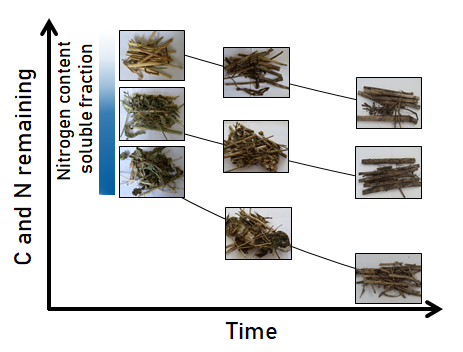Summer Cover Crops Shoot Decomposition and Nitrogen Release in a No-Tilled Sandy Soil
01/Nov/2019
ABSTRACT Cover crops have numerous benefits when used in a no-till system. Understanding the processes of decomposition and N release of summer cover crops (SCC) may help select species and management to be used in cropping systems. This study aimed to evaluate C and N loss of SCC shoots. Six SCCs were evaluated: velvet bean (Mucuna aterrima), pearl millet (Pennisetum americanum), dwarf pigeon pea (Cajanus cajan), sunn hemp (Crotalaria juncea), showy rattlebox (Crotalaria spectabilis), and jack bean (Canavalia ensiformis). The […]
Recommendation of soil fertility levels for willow in the southern highlands of Santa Catarina
01/Jun/2012
The species Salix x rubens is being grown on the Southern Plateau of Santa Catarina since the 1940s, but so far the soil fertility requirements of the crop have not been assessed. This study is the first to evaluate the production profile of willow plantations in this region, based on the modified method of Summer & Farina (1986), for the recommendation of fertility levels for willow. By this method, based on the law of Minimum and of Maximum for willow production for […]
Triticale, pearl millet and phosphates for no-till straw production
01/Jun/2011
Water soluble phosphates are the most often used phosphorus sources in fertilizers for ease of P release to the soil. However, in tropical soils, much of this P is adsorbed to soil particles and becomes unavailable to plants. Conversely, reactive phosphates may be slow initial releasers of the nutrient, but be released continually to the developing crops, reducing soil P fixation. The aim of this study was to investigate the application of two P sources to triticale and assess the […]
Relationships between size of eroded sediments, runoff velocity, surface roughness created by tillage, and size of aggregates in a soil submmited to different managements
01/Oct/2009
Several factors determine the selectivity of the soil erosion process by rainfall concerning the size of eroded-sediments transported in the runoff water. Among them, it is important to point out the intensity of the rainfall and its associated runoff, the texture and degree of consolidation of the soil surface layer, the form of erosion (interill, rill, or gully), the microrelief of the terrain or surface roughness created by tillage, and the size and stability of the soil aggregates. Considering that, […]
Soil and water losses by rainfall erosion influenced by tillage methods, slope-steepness classes, and soil fertility levels
01/Aug/2003
Erosion is the most deleterious form of soil degradation. Besides reducing the productivity capacity for crops, it can cause serious environmental problems, such as sedimentation and pollution of water sources. Yet the use of sound soil management systems and well-planned support conservation practices can solve erosion problems satisfactorily. In order to obtain quantitative information on the subject as guidelines for conservation plans, an erosion experiment under natural rainfall was conducted on a very clayey soil (Typic Haplortox), in Santo Ângelo, […]
Effect of tillage and cropping systems on soil organic matter dynamics and atmospheric CO2 mitigation in southern Brazil
01/Sep/2000
In this study, a first order exponential model was adjusted to the experimental data of soil organic carbon (OC) and total nitrogen (TN) of a 9-year-old experiment in southern Brazil. Parameters of soil organic matter dynamics were determined and the soil OC and TN stocks simulated in a Paleudult soil under three tillage systems (conventional tillage: CT, reduced tillage:RT, and no-tillage:NT) and three cropping systems (oat/maize-O/M, oat + vetch/maize-O + V/M and oat + vetch/maize + cowpea-O + V/M + […]

